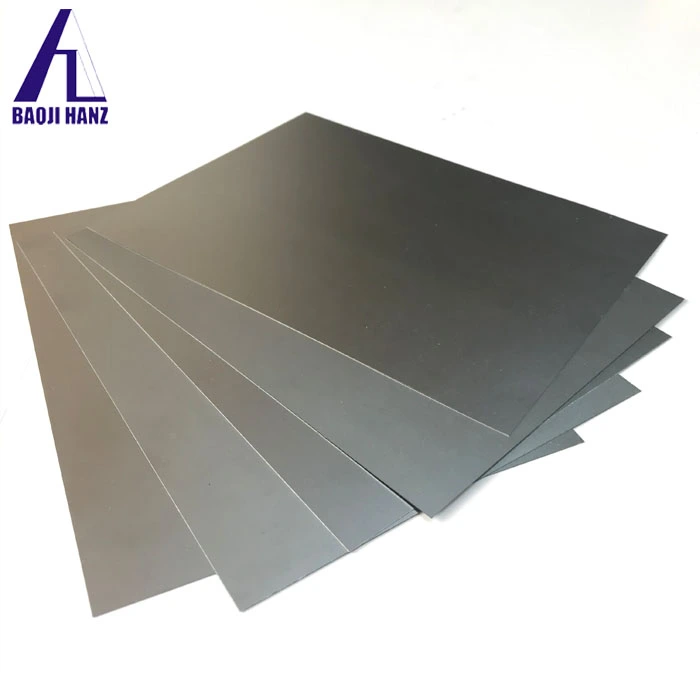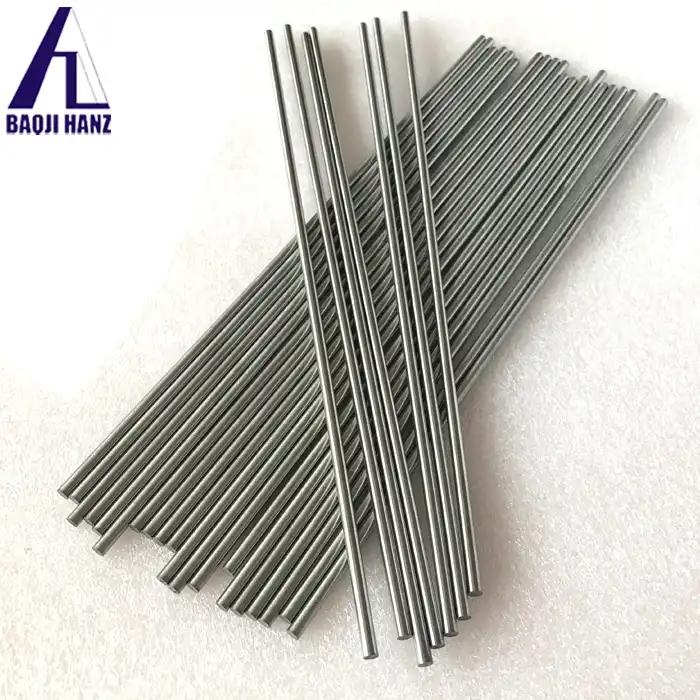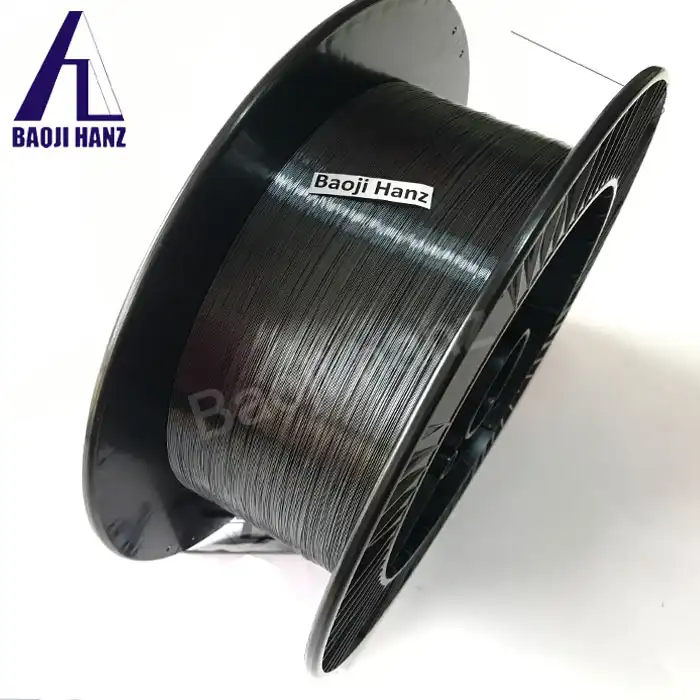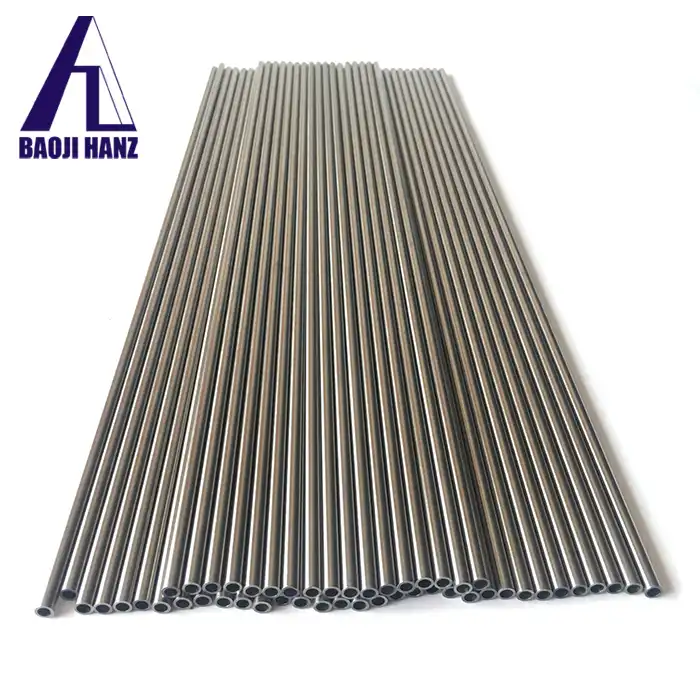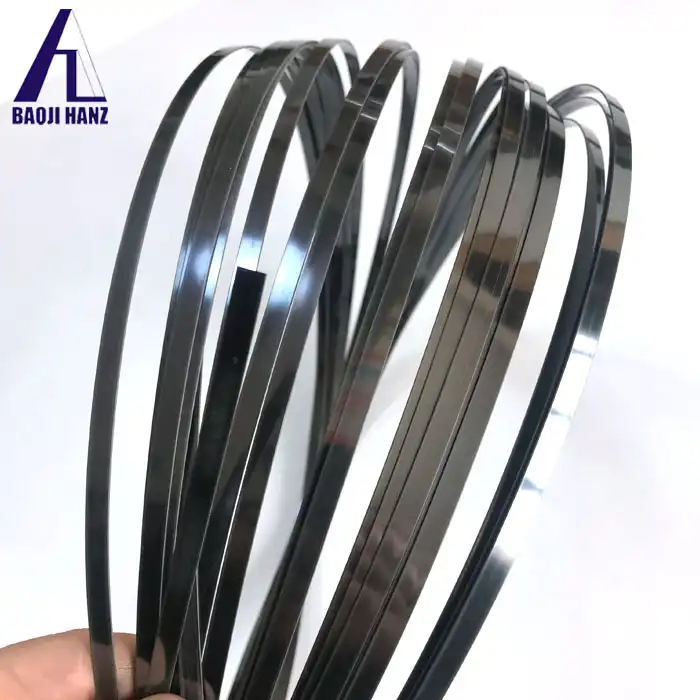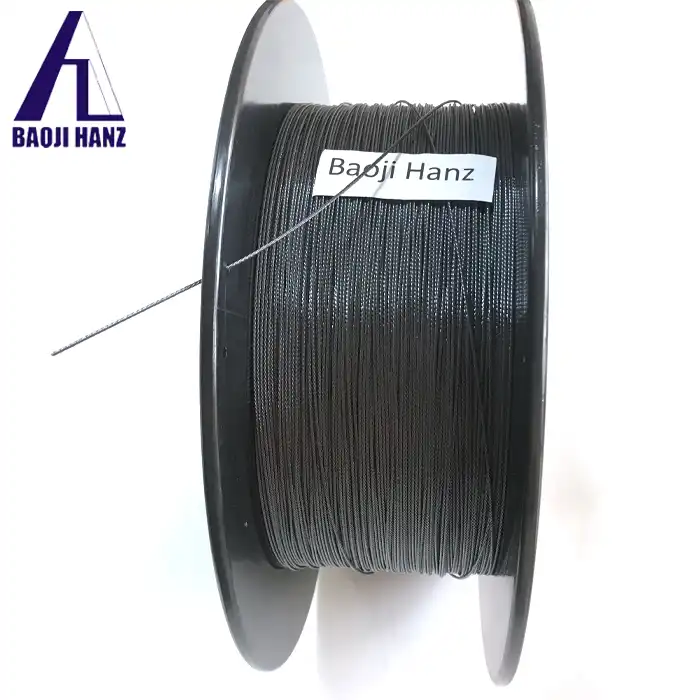How does superelastic titanium nickel alloy wire work in orthodontics?
2025-04-17 19:14:23
Superelastic titanium nickel alloy wire, also known as nitinol, has revolutionized modern orthodontic treatment by providing dentists with a material that can exert gentle, consistent forces for tooth movement. Medical superelastic titanium nickel alloy wire has unique properties that make it ideal for orthodontic applications. Unlike conventional stainless steel wires, these superelastic wires maintain nearly constant force over a wide range of deflections, which results in more physiologic tooth movement and reduces the need for frequent adjustments. This remarkable material has transformed orthodontic treatment by improving patient comfort, reducing treatment time, and enabling more predictable clinical outcomes.
The Science Behind Superelastic Properties in Orthodontic Wires
Metallurgical Composition and Phase Transformation
Medical superelastic titanium nickel alloy wire derives its exceptional properties from its unique metallurgical composition. Typically containing approximately 55-56% nickel and 44-45% titanium, this alloy undergoes a reversible solid-state phase transformation between austenite (high-temperature phase) and martensite (low-temperature phase). This transformation is responsible for both the shape memory effect and superelasticity that make these wires so valuable in orthodontics. When a Medical superelastic titanium nickel alloy wire is subjected to stress, it transforms from austenite to stress-induced martensite, allowing substantial deformation without permanent damage. Upon removal of the stress, the wire returns to its original shape as the material transforms back to austenite. This unique behavior allows orthodontists to engage severely misaligned teeth with minimal risk of permanently deforming the archwire.
Baoji Hanz Metal Material Co., Ltd. manufactures these wires with strict control of the material composition (Titanium-Nickel Alloy - NiTi), ensuring that each batch meets the specifications needed for optimal phase transformation characteristics. Their advanced production facilities, located in the Baoji Titanium Valley Nonferrous Metals Base, utilize precise manufacturing processes to maintain consistency in the alloy's composition, which is critical for predictable clinical performance. The company's ISO9001:2015 and ISO13485:2016 certifications ensure that their Medical superelastic titanium nickel alloy wire meets the highest quality standards for medical applications.
Load-Deflection Characteristics and Force Delivery
The load-deflection characteristics of Medical superelastic titanium nickel alloy wire represent one of its most significant advantages in orthodontic applications. Unlike conventional alloys that demonstrate linear elastic behavior, superelastic NiTi wires exhibit a unique stress-strain curve with a pronounced plateau region. This plateau corresponds to the phase transformation from austenite to martensite, allowing the wire to deliver nearly constant forces over a wide range of activations. This behavior is particularly beneficial in the initial stages of orthodontic treatment when teeth may be severely misaligned.
Medical superelastic titanium nickel alloy wire from Baoji Hanz showcases exceptional superelasticity, ensuring flexibility and resilience critical for orthodontic applications. Their wires maintain force levels within the optimal range for tooth movement (50-100 grams) even when deflected by several millimeters. This characteristic reduces the risk of root resorption and patient discomfort that can occur with excessive forces. Additionally, the wire's fatigue resistance makes it suitable for repeated mechanical stress throughout the treatment period. The company offers these wires in a diameter range from 0.1mm to 5mm, allowing practitioners to select the appropriate size for different treatment phases and clinical requirements.
Temperature Sensitivity and Oral Environment Effects
The behavior of Medical superelastic titanium nickel alloy wire is influenced by temperature, which has important clinical implications in orthodontics. These wires can be engineered to have different transformation temperatures, allowing for manipulation during placement and activation in the oral environment. Many superelastic NiTi wires are designed to be in the martensite phase at room temperature, making them more flexible for insertion, and then transform to austenite at oral temperature, where they express their superelastic properties and begin to apply force for tooth movement.
Baoji Hanz's Medical superelastic titanium nickel alloy wire is carefully engineered to function optimally in the oral environment, considering factors such as temperature fluctuations, presence of saliva, and exposure to various foods and beverages. Their wires exhibit excellent corrosion resistance, withstanding body fluids and sterilization processes without degradation in performance. This durability ensures consistent force delivery throughout the treatment period, even under challenging conditions. The company's commitment to precision manufacturing results in tight dimensional tolerances for consistent performance across batches, an essential factor for predictable clinical outcomes. Their secure and sterile packaging protects the wire's properties until it's ready for clinical use.
Clinical Applications and Benefits in Modern Orthodontics
Alignment Efficiency and Treatment Time Reduction
Medical superelastic titanium nickel alloy wire has significantly improved the efficiency of the alignment phase in orthodontic treatment. The wire's ability to maintain constant force levels over extended periods means that teeth move more predictably and continuously, often reducing overall treatment time compared to traditional wires. Studies have shown that initial alignment can be achieved up to 50% faster with superelastic NiTi wires compared to stainless steel or conventional NiTi wires.
Baoji Hanz Metal Material Co., Ltd. offers Medical superelastic titanium nickel alloy wire that exemplifies these benefits, with their products demonstrating superior alignment efficiency in clinical settings. Their wires, available in various sizes and specifications to meet specific requirements, provide orthodontists with the flexibility to choose the optimal wire for each phase of treatment. The high strength-to-weight ratio ensures lightweight yet robust performance, reducing the burden on anchorage teeth while maintaining effective force delivery. Orthodontists using Baoji Hanz's wires report more predictable initial alignment, allowing them to proceed to working wires sooner in the treatment sequence. This efficiency is particularly valuable in today's orthodontic practice, where patients increasingly demand shorter treatment times without compromising results.
Patient Comfort and Compliance Improvements
One of the most significant clinical advantages of Medical superelastic titanium nickel alloy wire is the improvement in patient comfort. The constant, low-force characteristics of these wires result in less pain and discomfort following adjustments, which traditionally has been a major complaint among orthodontic patients. This improved comfort profile leads to better patient compliance, fewer missed appointments, and greater overall satisfaction with treatment.
Baoji Hanz's Medical superelastic titanium nickel alloy wire products are designed with patient comfort as a primary consideration. Their wires meet medical-grade safety standards for biocompatibility, minimizing the risk of adverse reactions that could cause discomfort or complications. The precision manufacturing process ensures smooth surfaces without irregularities that could irritate oral tissues. Patients treated with these wires typically report less pain and discomfort during the initial alignment phase compared to conventional wires. This improved comfort profile has significant implications for practice management and patient satisfaction, as comfortable patients are more likely to comply with treatment protocols and refer others to the practice. The wire's ability to reduce the frequency of adjustments also means fewer office visits, which patients appreciate in their increasingly busy lives.
Complex Malocclusion Management and Clinical Versatility
Medical superelastic titanium nickel alloy wire has expanded the range of malocclusions that can be effectively treated with fixed appliances. The wire's exceptional flexibility allows engagement of severely rotated or ectopically positioned teeth that would be difficult or impossible to incorporate with conventional wires. This versatility has made superelastic NiTi the wire of choice for initial alignment in most contemporary orthodontic practices.
Baoji Hanz Metal Material Co., Ltd. produces Medical superelastic titanium nickel alloy wire that is widely used across various orthodontic applications. Their wires demonstrate exceptional performance in complex cases, including severe crowding, impacted teeth, and crossbites. The shape memory effect allows the wire to recover its original shape after deformation, which is particularly valuable when treating teeth that are significantly out of the arch form. Beyond orthodontics, their medical-grade wires find applications in cardiology (stents and guidewires), surgery (sutures and needles), neurology (micro-guidewires for minimally invasive procedures), and orthopedics (intramedullary fixation devices). The company's commitment to customization through OEM services ensures that practitioners can obtain wires tailored to specific clinical requirements, whether for particular bracket systems, treatment philosophies, or patient populations.
Manufacturing Innovations and Future Developments
Advanced Production Techniques and Quality Control
The manufacturing of Medical superelastic titanium nickel alloy wire requires specialized knowledge and equipment to ensure consistent performance in clinical applications. The production process involves precise control of alloy composition, heat treatment parameters, and surface finishing to achieve the desired superelastic properties and biocompatibility.
Baoji Hanz Metal Material Co., Ltd. has invested in state-of-the-art production facilities to manufacture their Medical superelastic titanium nickel alloy wire. Their factory in the Baoji Titanium Valley Nonferrous Metals Base employs advanced melting, drawing, and heat treatment equipment specifically designed for nickel-titanium alloys. Each batch of wire undergoes rigorous testing for chemical composition, transformation temperatures, mechanical properties, and surface quality. Their ISO9001:2015 and ISO13485:2016 certifications demonstrate their commitment to consistent quality management processes. With a large amount of ready stock available, they can offer quick delivery times while maintaining stringent quality standards. Their factory outlet approach provides pricing advantages without compromising on quality, making advanced orthodontic treatment more accessible to practitioners and patients worldwide. The company's minimum order quantity (MOQ) of just one piece reflects their commitment to serving both large orthodontic suppliers and individual practices with the same level of quality and service.
Surface Treatments and Friction Reduction Innovations
Friction between archwires and brackets represents a significant challenge in orthodontic treatment, potentially slowing tooth movement and increasing treatment time. Recent innovations in Medical superelastic titanium nickel alloy wire manufacturing have focused on surface treatments to reduce friction and improve sliding mechanics.
Baoji Hanz Metal Material Co., Ltd. has developed proprietary surface treatment processes for their Medical superelastic titanium nickel alloy wire that significantly reduce friction while maintaining the wire's superelastic properties. These treatments create smoother surfaces at the microscopic level, facilitating easier sliding of the wire through brackets. Some of their premium wire products incorporate ion implantation or coating technologies that can reduce friction by up to 70% compared to untreated wires. This reduction in friction translates to more efficient tooth movement and potentially shorter treatment times. The company's R&D team continuously explores new surface modification techniques to further enhance the performance of their wires. These innovations reflect the company's seven years of expertise in Nitinol Shape Memory Alloy, Superelastic Nitinol Alloy, and Nickel Titanium Alloy, positioning them at the forefront of orthodontic wire technology.
Emerging Applications and Future Research Directions
The unique properties of Medical superelastic titanium nickel alloy wire continue to inspire research and development of new orthodontic applications and techniques. Current investigations focus on combining superelasticity with other desirable properties, such as aesthetic appearance, antibacterial characteristics, and smart material capabilities that respond to specific oral environment stimuli.
Baoji Hanz Metal Material Co., Ltd. actively participates in research collaborations to explore new applications for their Medical superelastic titanium nickel alloy wire. Their materials science team works with orthodontic researchers to develop next-generation wires that address current clinical limitations. Promising areas of development include temperature-activated wires with more precisely controlled transformation ranges, hybrid wires that combine the benefits of different materials, and smart wires that can change properties in response to specific stimuli. The company's OEM capabilities allow them to prototype and manufacture experimental wires for research purposes, facilitating the advancement of orthodontic science. Their products are already finding applications beyond traditional orthodontics, including lingual orthodontics, clear aligner auxiliary systems, and temporary anchorage device-supported mechanics. These emerging applications highlight the versatility and ongoing relevance of superelastic nickel-titanium technology in modern dentistry.
Conclusion
Medical superelastic titanium nickel alloy wire has fundamentally transformed orthodontic practice through its unique combination of flexibility, force control, and shape memory. These properties have improved treatment efficiency, patient comfort, and clinical outcomes across a wide range of malocclusions. As manufacturing techniques continue to advance, we can expect further innovations that expand the capabilities and applications of this remarkable material.
Are you looking to elevate your orthodontic outcomes with premium-quality superelastic nickel-titanium wires? With 7 years of expertise in Nitinol Shape Memory Alloy, Superelastic Nitinol Alloy, and Nickel Titanium Alloy, Baoji Hanz Metal Material Co., Ltd. is your trusted partner for superior orthodontic materials. Save money with our direct supply and cost advantages, and benefit from fast delivery from our large stock of standard sizes. Contact us today to discuss your specific requirements – whether you need custom specifications, specialized alloy compositions, or unique packaging solutions, our team is ready to provide personalized service that fits seamlessly into your practice workflow. Reach out to us at baojihanz-niti@hanztech.cn to explore how our premium nickel-titanium products can enhance your clinical success.
Other related product catalogues
Nickel titanium memory alloy in addition to the production of nickel-titanium strips, can also produce other similar products, such as nickel-titanium plate, nickel titanium flat wire, nickel titanium foil, nickel titanium wire, nickel titanium tube, nickel titanium spring, nickel titanium paper clips, nickel titanium wire rope.
|
|
|
|
|
|
|
|
References
1. Miura F, Mogi M, Ohura Y, Hamanaka H. The super-elastic property of the Japanese NiTi alloy wire for use in orthodontics. American Journal of Orthodontics and Dentofacial Orthopedics. 1986;90(1):1-10.
2. Kusy RP. A review of contemporary archwires: their properties and characteristics. Angle Orthodontist. 1997;67(3):197-207.
3. Proffit WR, Fields HW, Sarver DM. Contemporary Orthodontics. 5th ed. St. Louis: Mosby Elsevier; 2013.
4. Thompson SA. An overview of nickel-titanium alloys used in dentistry. International Endodontic Journal. 2000;33(4):297-310.
5. Gurgel JA, Kerr S, Powers JM, LeCrone V. Force-deflection properties of superelastic nickel-titanium archwires. American Journal of Orthodontics and Dentofacial Orthopedics. 2001;120(4):378-382.
6. Burstone CJ, Qin B, Morton JY. Chinese NiTi wire—A new orthodontic alloy. American Journal of Orthodontics. 1985;87(6):445-452.

